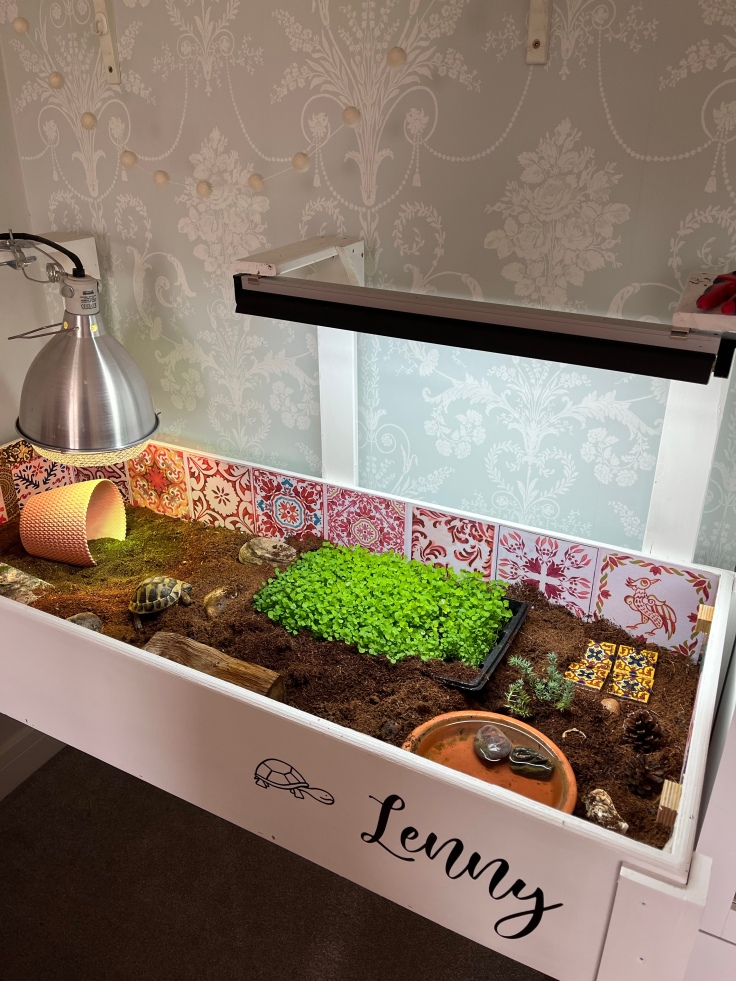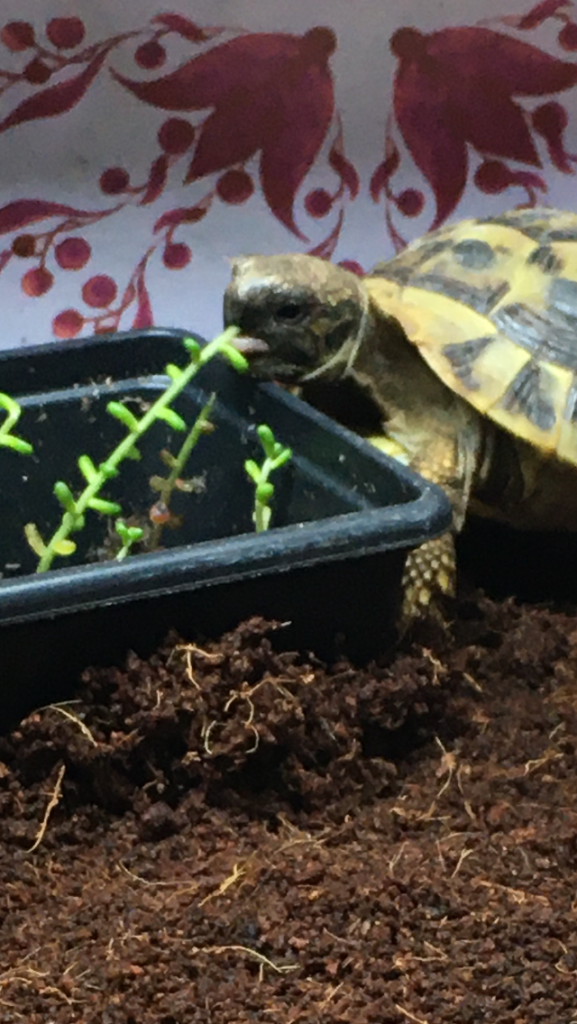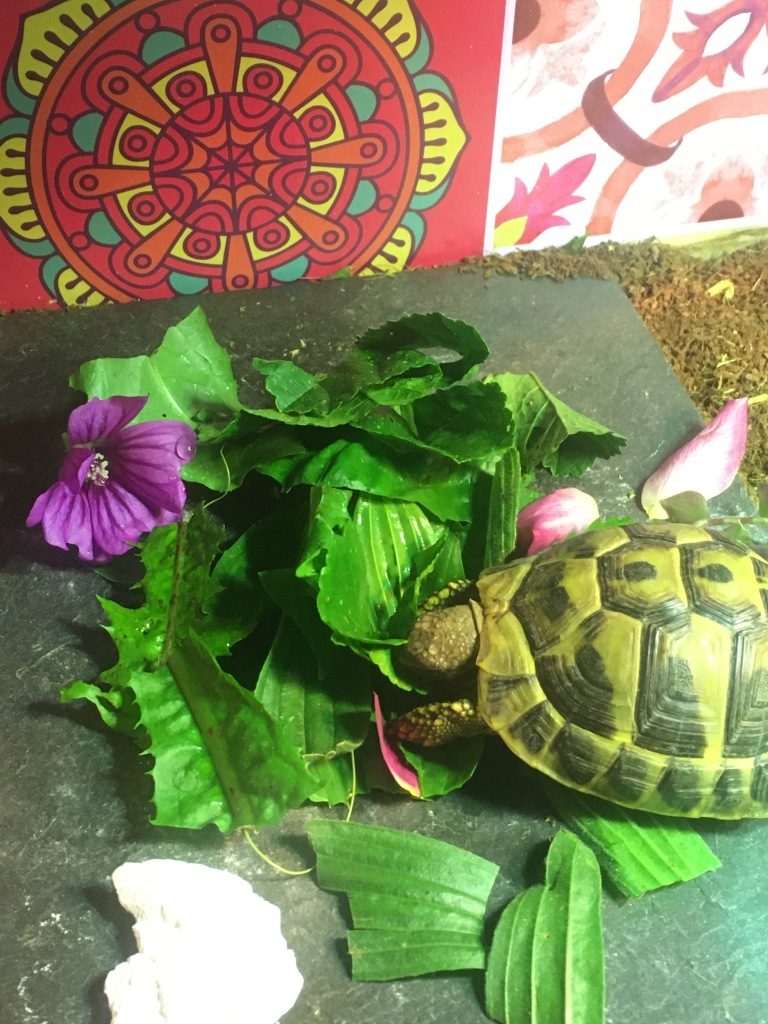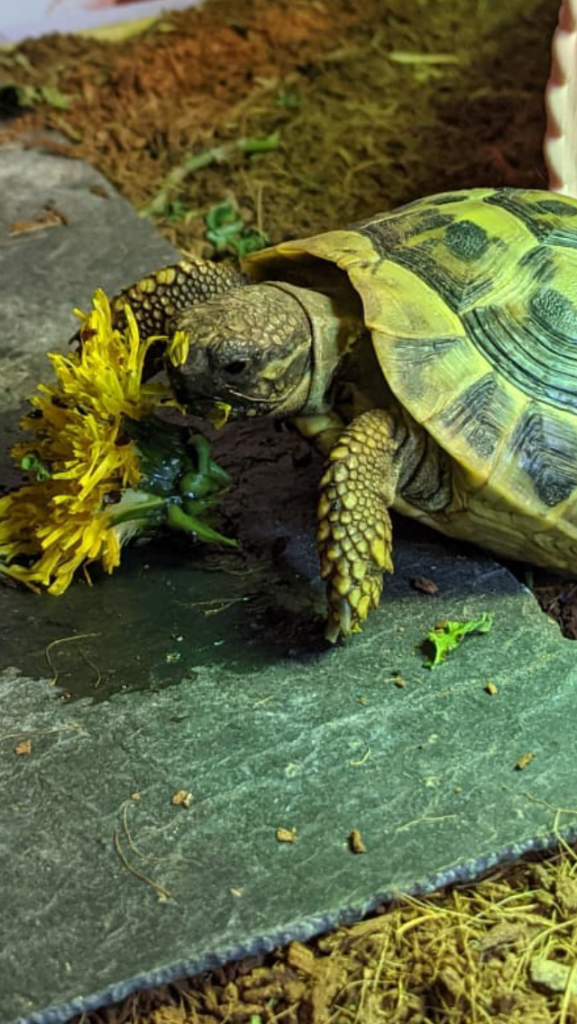Time to read: 8 minutes
Whether you are a new or experienced tortoise owner, it can be worrying when your tortoise stops eating or refuses the food you feed him. Rest assured though, because this can be a common problem and one that I experienced in the past when I first got my tortoise. My Mediterranean Herman’s tortoise is now a voracious eater and eats most of the fresh foods that I put out for him each day.
An otherwise well-fed, healthy tortoise usually can go a week or two without eating but this is obviously not advisable. If your tortoises is refusing food and you have the correct set up outlined below and here , the best practice is to have your tortoise seen by your veterinarian to rule out any underlying health conditions.
Tortoise Husbandry to check if your tortoise is refusing food
Here are some immediate things you can check if your Mediterranean/Russian tortoise is not eating:
Water
Always ensure that your tortoise has access to fresh water. I tend to put down a terracotta saucer of fresh water daily- big enough for him to get in and soak/drink and because he’s marching through it several times a day, the water can get murky or get spilled/absorbed by the substrate so often I have to refill or clean the dish a couple times a day but if this is not done more than once, I don’t worry too much: I know my tortoise is going into the water so I know he is hydrating.
He is also eating well so I know he is getting some water intake with his food.
Finally, I tend to mist his shell and substrate daily to help with moisture levels within his environment.
Soaking
Many tortoise keepers maintain a soaking/bathing regimen as this is another way to keep your tortoise hydrated.
It may also be a temporary measure to warm up a cold tortoise. Save to clean my tortoise’s shell if he’s particularly grubby, I personally do not bother with soaks. My tortoise has no problem drinking and getting into the water I provide for him, but soaking is something you can try if the water in your tortoise’s enclosure remains untouched, (far from the most elegant creatures, it is not hard to see evidence of tortoise-water dish interaction).
For baths and soaks, use warm water in a shallow container. I use an old ice cream tub and use just enough water so that Lenny’s head rests well above the water line. Best practice is to bathe/soak in a designated container for your tortoise. Tortoises may also carry salmonella so best not to use any containers meant for any other animal or purpose. This includes other species of tortoises to avoid any kind of cross-contamination of diseases.
Temperatures
Tortoises can not self-thermoregulate so they need additional heat in their enclosures by way of lamps. They will not eat if they are too cold. Signs of cold in your tortoise: The Top of your tortoise shell should feel warm and not cold to the touch, if your tortoise is trying to dig down and hide under substrate or things within their enclosure for most of the day, this could be signs that your tortoise is cold and you may need to check your temps.
There should be a temperature gradient in their enclosure with one side the “warm” end containing a mounted basking bulb in a clamp lamp (placed straight downwards, not at an angle) with a basking temperature of between 30-35 degrees celsius / 86-90 degrees Fahrenheit. The other end of the enclosure or table should be kept at ambient temperatures of around 21-24C / 69F, with night time tempertures of 15-18C / 59-64F.

What to do if your tortoise won’t eat a variety of foods
Like us, tortoises thrive on a balanced, varied diet but they also have their favourite foods which might not be the most nutrient dense for them- Lettuce, for example, may be a favourite but is what a McDonald’s meal is for humans: fine as part of a varied diet but will do us harm if that is all we were to live on.
So what to do if you wish to introduce unfamiliar, healthy (please us the free database here to determine the most healthy foods to feed your tortoise- all colour coded with GREEN codes the best foods.) foods into your tortoise’s diet?
The first thing is not to give up if at first you don’t succeed in getting him to accept the diet change. Remember that tortoises live long lives and they don’t tend to take too kindly to change. That includes a switch in diet or within their enclosure. But we have to be more stubborn than they are- what may seem like a long time to us of our tortoise refusing to eat, is not in fact a long time in “tortoise time”. They truly will not starve themselves to death.
Many people feed a diet of lettuce leaves and cucumber because they are well known to be tortoise favourites, but resist the urge to continue doing so if your tort refuses to accept a change or new foods. You should be prepared to see the introduction of variety as a “campaign” that may last weeks or even months but trust that your efforts WILL eventually pay off and be much better for the health of your tortoise in the long run.
Some things to try when attempting to expand your tortoise’s diet:
- Start small- slowly add variety to their diet along with the cucumber/lettuce/pellets that you have already been feeding. Keep doing this for about 2-3 weeks. Monitor what is being eaten and what is being left.
- Try mashing the cucumber up and putting the juices over the foods your tortoise leaves. The cucumber juice may help to entice them.
- Chop a variety of leaves up into small pieces so what is what is virtually unrecognisable. Better still if there is cucumber in the mix.
- Try having some small plants in their enclosure for him to forage himself: sedum, tradescantia and turtle vine work well for as they are tasty snacks and they remain small, low-growing plants for long so perfect for the space within a tortoise enclosure. Be sure to wedge small pot plants well into the substrate for anchorage and at an angle for easy access.



- If it has been about 3 weeks and the tortoise still refuses to eat a varied amount of plants that have been offered, start offering ONLY the healthy weeds and flowers. No more cucumber, lettuce or pellets. Cut them off. Cold turkey.
- When I first got my tortoise, this is the route I resorted to. In my case, before I got my tortoise, I did as much research as I could so I already had a greenhouse full of homegrown plants ready to feed him, I had identified all the spots in my local area where the good weeds grew so I knew what to go to to forage for him. So imagine my dismay when my carefully cultivated plants were snubbed.
Every day, I dutifully arranged a pretty array of leaves, flowers and cucumber on his slate, a presentation to rival the best gastro pub meal, only for it to be ignored all day, dragged around the enclosure, pooed on etc.
But the next day, I would clear everything up, check his temps, change his water and try again with a fresh batch of food.
By about week 3…or 4 there was a breakthrough. Things were being picked at and eaten. Now, 4 years later, my boy is thriving and thoroughly enjoys his meals and is always ready on his slate ready for his meal.

Sure, he has his favourite plants: chicory, raddicchio, red lettuce, dahlia and cucumber- and there are things Leonard tends to leave uneaten: buddleia flowers, red valerian and dandellion flowers.
But it should be noted that tortoises are funny creatures. Sometimes they turn their noses up at certain things and then you try them again months or a year later and that same plant is decimated so it’s always worth trying again even if it seems your tortoise does not like a particular tortoise-safe feed, especially if it is a plant you have easy access to!

I hope these words encourage you to keep trying when you have difficulty feeding your tortoise. Feed a variety of tortoise safe leaves, weeds and flowers once a day (aim for a portion roughly the same size of their shell), monitor food intake (I used to keep a food diary to get to know what his likes and dislikes were to keep those on a steady rotation), continue to expand his diet but if you are worried, do not hesitate to have them looked at by your vet.

thanks – my grandkids tortoise but I’m concerned he/she is not getting best from me
LikeLiked by 1 person
Hi, thank you for commenting, I know it can be difficult but try not to be too hard on yourself and overthink things. I found starting simple with the key basics of husbandry- a basic set up with the correct kit and start by identifying a few safe plants that you have access to and are nutritious for your tortoise (find that on my page and on the tortoise table.org) and build from there. I’m sure you and your tort are doing just great!
LikeLike